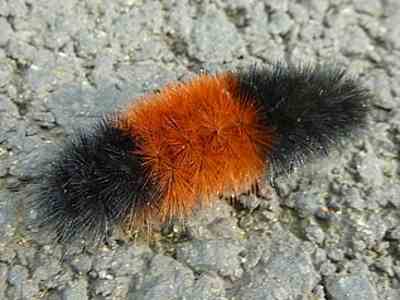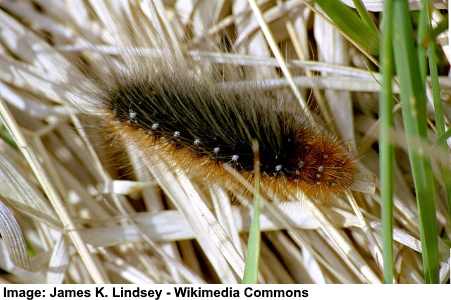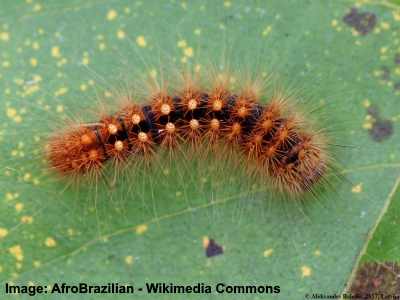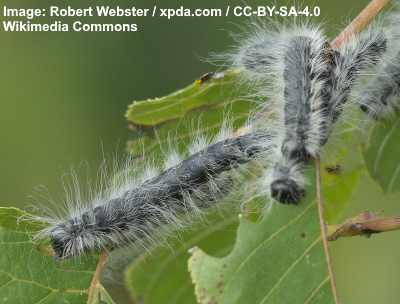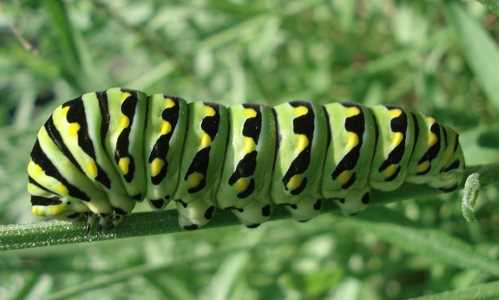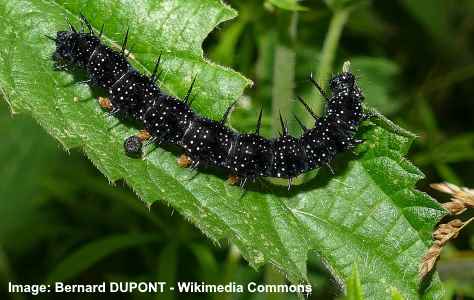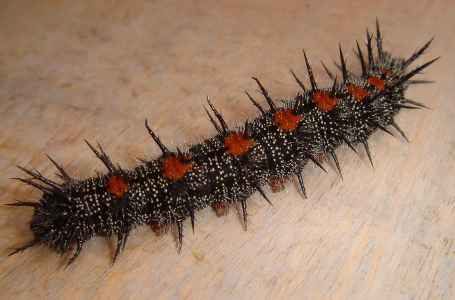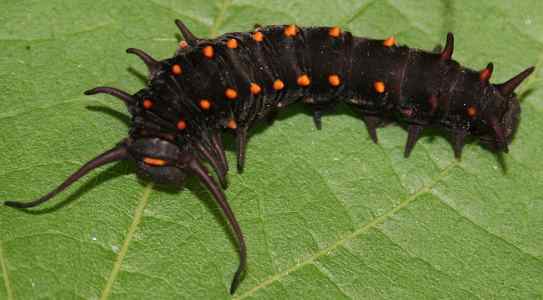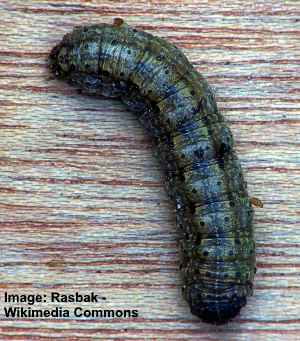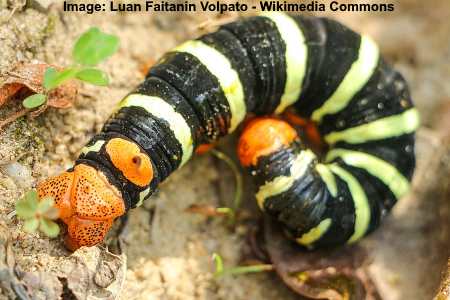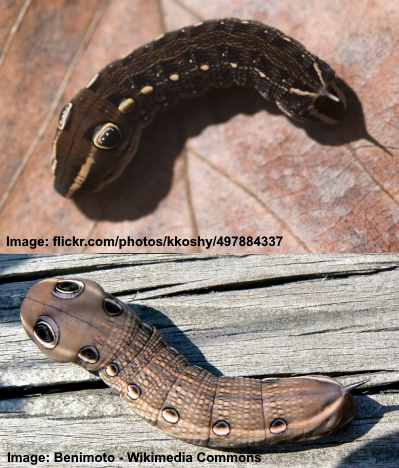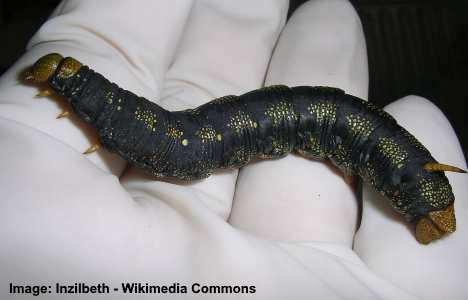16 Black Caterpillars (Including Fuzzy): Identification Guide with Pictures

Black caterpillars are insects that come in all shapes and sizes. All species of caterpillars belong to the order of insects called Lepidoptera. After hatching from an egg, caterpillars gorge on a diet of plant and tree leaves. Many types of black caterpillars are interesting to look at and some look quite scary. Some species of caterpillars are black and fuzzy with hair-like spines. Other common black caterpillars have vibrant orange or yellow markings.
Even though some black caterpillars may look unsightly and unappealing, they turn into beautiful butterflies or moths. For example, the Monarch caterpillar is black with white and yellow tiger-like stripes. After the pupal stage, this caterpillar turns into the stunning Monarch butterfly.
Most silky black caterpillars are harmless and don’t sting, even though they may look menacing. Many of the big black fuzzy caterpillar species have spines and setae (fine bristles) that can be irritating. Although these black worms look hairy and fluffy, they can have spines that give a nasty sting.
Black Caterpillar Identification
Identifying black caterpillars requires noting details such as the type of hairy covering, and specific markings such as stripes and spots. Some types of furry caterpillars also look deceiving. For example, some woolly caterpillars look like soft furry worms. However, their bristles are a defense mechanism and it can be spiky and sore.
In this article, you will learn about the most commonly-found types of black caterpillars with pictures. You will find out how to identify the different caterpillar species and what their unique characteristics are.
Types of Black Caterpillars: Identification Guide
Here are some of the common types of black caterpillars, starting with the black fuzzy caterpillars:
Black Fuzzy Caterpillars (with Pictures): Identification Guide
First of all, let’s look at some of the most unusual types of black caterpillars – black fuzzy ones.
Woolly Bear Caterpillar (Pyrrharctia isabella) – Fuzzy Caterpillar
The Woolly Bear caterpillar (Pyrrharctia isabella) is a fuzzy, black and brown caterpillar commonly seen in late summer. Short, spiky tufts of fuzzy hairs cover this caterpillar, serving as protection from predators. It can be easily identified by the wide brown or orange band around its middle and its black ends.
Black and brown caterpillars such as the Woolly Bear aren’t poisonous or a stinging variety. Usually, handling one of these fuzzy worm-like creatures with their spiky tufts of hair may cause skin irritation or contact dermatitis.
One characteristic of the Woolly Bear caterpillar is its defense mechanism. When under threat, the caterpillar rolls up into a spiky ball. When the threat has gone, they quickly crawl away to safety.
Also called the Isabella Tiger Moth caterpillar, this spiky looking insect feeds on herbs, tree leaves, and other plants.
Identifying features
Short spiky tufts of brown/orange and black hairs cover this species of furry caterpillar.
One of the larger types of black furry caterpillars that grows up to 2.3” (6 cm) in length.
- Adult Stage: The adult form of this caterpillar is the Isabella Tiger Moth
- Host Plants: Woolly Bear Caterpillars are known to feed on a variety of plants such as aster, clover, birch, maple, elm, sunflower, and corn
- Habitat and Distribution: They can be found in open fields, gardens, and meadows across North America, particularly in the United States and southern Canada
- Stinging: Handling one of these fuzzy worm-like creatures with their spiky tufts of hair may cause skin irritation or contact dermatitis
Giant Leopard Moth Caterpillar (Hypercompe scribonia) – Black Fuzzy Caterpillar
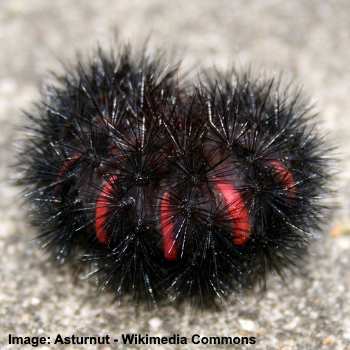
The Giant Leopard caterpillar is black spiky caterpillar that also has red stripes between its black segments.
The Giant Leopard caterpillar (Hypercompe scribonia) is a black spiky caterpillar that can be found munching on your garden plants. Although these black fuzzy caterpillars look soft and fluffy, their black spines are sharp and needle-like.
One of the interesting features of the black Giant Leopard caterpillar species is the red stripes (bands) between its black segments. When the caterpillar is crawling, these appear to give the spiky caterpillar a black and red fuzzy appearance. This species of caterpillar doesn’t sting but the spikes can be sore if they prick your skin.
You will find these black and red caterpillars in Texas, Florida, Mexico, and along the East coast of the US.
Identifying features
The Giant Leopard moth caterpillar is a black fuzzy caterpillar with black spikes that are sharp and stiff. When the Giant Leopard caterpillar rolls up to defend itself, striking red stripes appear between sharp black spikes that cover the caterpillar.
The Giant Leopard species don’t grow longer than 2” (5 cm).
- Adult Stage: The adult form of this caterpillar is the Giant Leopard Moth
- Host Plants: These caterpillars feed on a variety of plants, including dandelion, plantain, and violets.
- Habitat and Distribution: Giant Leopard Moth Caterpillars can be found in meadows, gardens, and open woodlands across North America, particularly in the eastern United States
- Stinging: Their black spines are sharp and needle-like
Garden Tiger Moth Caterpillar (Arctia caja)
The Garden Tiger caterpillar (Arctia caja) is a type of ‘woolly bear’ that has a fuzzy appearance. This blackish caterpillar belongs to the Artica genus in the Erebidae family of crawling insects.
The long hair-like spines (setae) are black, orange, and grayish-white. This long caterpillar can be seen feeding on any kind of leaves. Garden Tiger caterpillars don’t sting but their fuzzy spines can cause skin irritation.
After pupation, the black and orange furry caterpillar emerges as a beautiful moth. This has a pair of black and white wings and a pair of orange wings with blue and black markings.
Identifying features
A fuzzy-looking black caterpillar with orange spines and long spiky gray hairs.
Like most woolly caterpillars, this species grows to around 2.3” (6 cm) in length.
- Adult Stage: The adult form of this caterpillar is the Garden Tiger Moth
- Host Plants: These caterpillars are known to feed on a wide range of plants, including dandelions, nettles, and other herbaceous vegetation
- Habitat and Distribution: Garden Tiger Moth Caterpillars are found in various habitats such as meadows, gardens, and grassy areas throughout Europe, Asia, and North America
- Stinging: They are not known to sting but their fuzzy spines can cause skin irritation
Scarce Dagger Moth Caterpillar (Acronicta auricoma)
The Scarce Dagger caterpillar (Acronicta auricoma) is a pure black fuzzy caterpillar with tufts of black and orange/yellow setae.
This species of black and orange caterpillar looks moderately fuzzy. There is one pair of small clumps of fine hairs on each segment. The spines at the head and tail and the ones in the middle are bright yellow or orange. These yellow and black caterpillar markings make it look like a wasp to predators.
Although not poisonous or toxic, the hairs on this furry black caterpillar species can be irritating on your skin.
The name of ‘dagger moth caterpillar’ comes from the markings on the adult moth.
Identifying features
Distinct yellow or white dots and tufts of yellow/orange spines on the black fuzzy caterpillar.
- Adult Stage: The adult form of this caterpillar is the Scarce Dagger Moth
- Host Plants: Scarce Dagger Moth Caterpillars feed on a variety of trees, including alders, oaks, and willows
- Habitat and Distribution: These caterpillars can be found in forests, woodlands, and other wooded areas in North America, including parts of the United States and Canada
- Stinging: Although not poisonous or toxic, the hairs on this furry black species can be irritating on your skin
Walnut Caterpillar (Datana integerrima) – Black and White Fuzzy Caterpillar
The Walnut caterpillar (Datana integerrima) is a black and white fuzzy caterpillar with long, white spindly spines covering its black body. This black and white fuzzy caterpillar belongs to the Notodontidae family.
One of the interesting features of the Walnut caterpillar is the way it moves in groups. Very often, these caterpillars are seen traveling in long lines with others. This is one reason why they are also called ‘processionary caterpillars.’
Despite this being a hairy caterpillar species, they are completely harmless and shouldn’t cause any irritation.
Identifying features
The fine grayish hairs covering the shiny plump black body give the caterpillar a fuzzy wispy look.
- Adult Stage: The adult form of this caterpillar is a moth
- Host Plants: Walnut Caterpillars feed on walnut trees and sometimes pecan trees
- Habitat and Distribution: They are commonly found in deciduous forests, orchards, and areas where walnut trees grow, primarily in North America
- Stinging: Walnut Caterpillars do not sting or cause skin irritation
Other Types of Black Caterpillars
Let’s look in more detail at some of the other fascinating black caterpillars in the Lepidoptera order of insects.
Black Swallowtail Caterpillar (Papilio polyxenes)
Immature Black Swallowtail butterfly caterpillars (Papilio polyxenes) have a short plump black body with yellow and white markings. As the larvae mature, they become a bright green type of caterpillar with black and yellow stripes.
Before they become mature caterpillars, Black Swallowtails have black and white saddle markings. This acts as a defense mechanism as they resemble bird droppings.
You can usually find them munching on carrot leaves, parsley, and other green leaves. In fact, this species is also called the ‘Parsnip Swallowtail’ or ‘Parsley worm’ as it loves to feed on these plants.
Identifying features
In its immature stage, these larvae have a black segmented body with rows of yellow and white dots. There are also tiny soft spikes on the segments.
- Adult Stage: The adult form of this caterpillar is the Black Swallowtail Butterfly
- Host Plants: Black Swallowtail Caterpillars primarily feed on plants in the carrot family, including carrots, parsley, and dill
- Habitat and Distribution: These caterpillars can be found in gardens, meadows, and open areas across North America
- Stinging: Black Swallowtail Caterpillars do not sting or cause skin irritation
Peacock Butterfly Caterpillar (Aglais io)
The Peacock caterpillar (Aglais io) is one of the most unusual and striking black caterpillars you will come across. These long-bodied caterpillars have a rounded black head and multiple segments. A striking feature of these insects is the number of spikes on each segment. Although the spines look threatening and sharp, they are completely harmless. In fact, the Peacock butterfly caterpillar is not a stinging variety.
Another identifying feature of this caterpillar species is the tiny white dots covering its body. These contrast with the shiny black segments giving the caterpillar a speckled appearance.
Identifying features
Soft black bristles and white dots cover the cylindrical slender body of the Peacock caterpillar.
This European variety of caterpillar grows to around 1.5” (4 cm) long.
- Adult Stage: The adult form of this caterpillar is the Peacock Butterfly
- Host Plants: Peacock Butterfly Caterpillars feed on stinging nettle (Urtica dioica) and, less commonly, on other plants
- Habitat and Distribution: They are found in meadows, gardens, and open woodlands in Europe and parts of Asia. This species is widespread throughout its range
- Stinging: Peacock Butterfly Caterpillars do not sting
Mourning Cloak Caterpillar (Nymphalis antiopa)
Another spiky black caterpillar is the Mourning Cloak species (Nymphalis antiopa). This spiny caterpillar is from the Nymphalidae family of insects. Because of its spiky look and love for elm leaves, this is also named the ‘spiny elm caterpillar.’ The long body is dark gray, almost black in color with reddish-orange markings on each segment. The whole body is covered in tiny white flecks similar to the Peacock caterpillar. There is also a darker black line running up the length of the body.
Even though the caterpillar looks jaggy, you don’t have to worry. The sharp shiny spines are not poisonous and they act as a defense mechanism against predators.
Identifying features
A spiky black body with a row of reddish-brown dots running up its back.
- Adult Stage: The adult form of this caterpillar is the Mourning Cloak Butterfly
- Host Plants: Mourning Cloak Caterpillars primarily feed on leaves of deciduous trees such as willow, poplar and elm. But may also eat leaves from other trees and shrubs such as hackberry, and birch
- Habitat and Distribution: These caterpillars can be found in forests, woodlands, and other wooded areas across North America, including parts of the United States and Canada
- Stinging: The caterpillars of the Mourning Cloak Butterfly do not sting
Pipevine Swallowtail Caterpillar (Battus philenor)
Another black spiky caterpillar is the Pipevine Swallowtail species (Battus philenor). This caterpillar is identified by its smooth body featuring bright red or orange spines. These caterpillars belong to the Papilionidae family.
One of the interesting features of caterpillars in this Troidini group is their defense abilities. The caterpillar can stick out a forked tongue-like object from behind their head. This looks like a snake’s tongue and is designed to frighten off predators.
These black and orange caterpillars feed on pipevine plants commonly found in Florida, Texas, and California. The caterpillars also ingest toxins from these plants which makes them distasteful to birds and insects who may want to eat them.
The reddish-orange and black spikes may look harmful, but in reality, this species of caterpillar doesn’t sting humans.
Identifying features
Jet black body with a number of red-orange spikes sticking out on all sides of its body.
- Adult Stage: The adult form of this caterpillar is the Pipevine Swallowtail Butterfly
- Host Plants: Pipevine Swallowtail Caterpillars primarily feed on pipevine plants (Aristolochia species)
- Habitat and Distribution: They can be found in regions where pipevine plants grow, including parts of North America
- Stinging: Pipevine Swallowtail Caterpillars do not sting or cause skin irritation
Black Cutworm (Agrotis ipsilon)
The Black Cutworm caterpillar (Agrotis ipsilon) is a fat long dark brown-gray caterpillar that looks almost black. There are no spikes, hairs, or spines on its shiny dark body.
Although called a worm, this is a true caterpillar species from the Noctuidae insect family. These long fat caterpillars get their name from their ability to cut down plants at their stem. Rather crawling up stems to feed on leaves, they destroy plants at their roots.
These plump segmented insects can range in color from gray to brown to almost black. You can recognize the head end of the caterpillar as it is covered in black freckles.
Identifying features
There are no special identifying features on the Black Cutworm apart from its smooth shiny body.
- Adult Stage: The adult form of this caterpillar is a moth
- Host Plants: Black Cutworms are known to feed on a variety of crops and grasses, including corn and other grains. Other host plants include vegetables such as lettuce, tomato, and cabbage
- Habitat and Distribution: They can be found in agricultural areas and fields in various parts of North America
- Stinging: Black Cutworms do not sting or cause skin irritation
Catalpa Sphinx Caterpillar (Ceratomia catalpae)
One striking species of black caterpillar is the Catalpa Sphinx (Ceratomia catalpae) or sometimes called the Catalpa Worm. Groups of these gorging caterpillars can quickly decimate leaves from trees. These are a type of hawk moth caterpillar in the Sphingidae family.
The Catalpa Sphinx caterpillars gradually become shiny jet black as they mature. Immature larvae are usually a light color with few markings. They become darker until they are pure black. Another identifying feature is their yellow markings along each side. These join together to become a yellow row on each side of the caterpillar.
Although this is a harmless variety of caterpillar, they have a menacing-looking long spike at their tail. You will also notice that their feet at the head end are black and their prolegs in the middle section are yellow.
Identifying features
This yellow and black caterpillar has a shiny black segmented body with yellow sides.
The Catalpa Sphinx is a large caterpillar that can grow to 2” (5 cm) in length.
- Adult Stage: The adult form of this caterpillar is the Catalpa Sphinx Moth
- Host Plants: Catalpa Sphinx Caterpillars feed on the leaves of catalpa trees (Catalpa species)
- Habitat and Distribution: They are commonly found in regions where catalpa trees grow, including parts of North America
- Stinging: Catalpa Sphinx Caterpillars do not sting or cause skin irritation
Azalea Caterpillar (Datana major)
One of the more unusual species of black caterpillar is the Azalea caterpillar (Datana major). This caterpillar species is generally found in Florida, Kansas, and in states along the East coast of the US.
The markings of the Azalea caterpillar are variable and can have more or less black markings. The caterpillar is identified by its globular orange head, orange rear part and multitude of yellow markings along its body. The long crawling insect also has unusual reddish-brown prolegs.
Looking up close, you will also notice spindly hairs sticking out from its body. Although this caterpillar species has spines, they are insignificant and it doesn’t look hairy or fuzzy.
In areas where these Datana caterpillars are prevalent, they can do a lot of damage to crops and plants. One of the problems for gardeners or farmers is that they often feed in groups.
Identifying features
Long black and yellow caterpillars with a silky-smooth body.
- Adult Stage: The adult form of this caterpillar is a moth
- Host Plants: Azalea Caterpillars primarily feed on azalea and rhododendron plants
- Habitat and Distribution: They can be found in regions where azalea and rhododendron plants grow, including parts of North America
Tersa Sphinx Caterpillar (Xylophanes tersa)
Another unusual dark or nearly black caterpillar variety is the Tersa Sphinx species (Xylophanes tersa). It is easy to identify these caterpillars in the Sphingidae family due to their fake eye markings along their back.
Tersa Sphinx caterpillars are found in Southern states such as Texas and Arizona as well as in Central and South America. The Tersa Sphinx can be a dark-colored caterpillar with distinct eye markings and a ‘horn’ at one end, or depending on its stage it can be light brown-beige color with dark brown eye markings.
Caterpillars in this genus get the name ‘sphinx’ from their tendency to rest with the front body reared up.
Similar to other ‘hornworms’ and hawk moth caterpillars, this species is harmless and doesn’t bite or sting.
Identifying features
A species of caterpillar with defensive markings that look like eyes.
- Adult Stage: The adult form of this caterpillar is the Tersa Sphinx Moth
- Host Plants: Tersa Sphinx Caterpillars feed on various plants, including members of the nightshade family (Solanaceae)
- Habitat and Distribution: They are found in regions where their host plants grow, including parts of North America and Central and South America
- Stinging: Tersa Sphinx Caterpillars do not sting or cause skin irritation
White-Lined Sphinx (Hyles lineata)
The White-lined Sphinx (Hyles lineata) is one of the most common hawk moths. This type of caterpillar varies in color with some larvae being black and orange and others being bright green.
One of the features of the black species of White-lined Sphinx is their single orange horn on their tail end. Sometimes, the horn can be yellow with a black tip. Although the horn looks like a stinger, it is completely harmless.
Like with other Sphinx caterpillars, there are distinctive white or orange markings on the body. These look like clusters of small dots with a pair of larger dots on the side of each segment.
The name of this caterpillar comes from the beautiful pink and white moths that emerge from the pupae.
Identifying features
A plump black body with orange markings and a unicorn-like spine on the back of the body.
- Adult Stage: The adult form of this caterpillar is the White-Lined Sphinx Moth
- Host Plants: White-Lined Sphinx Caterpillars feed on a wide range of plants, including members of the evening primrose family (Onagraceae)
- Habitat and Distribution: They are found in various habitats, including gardens and meadows, across North and South America
- Stinging: White-Lined Sphinx Caterpillars do not sting or cause skin irritation
Sweet Gale Moth Caterpillar (Acronicta euphorbiae)
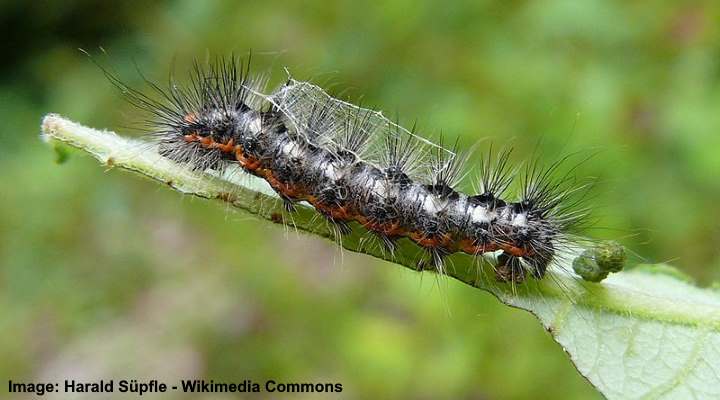
Sweet Gale Moth Caterpillar (Acronicta euphorbiae)
The Sweet Gale Moth Caterpillar is a captivating black caterpillar, marked by its striking contrast of colors. In its early stages, it has a dark gray or black body, accentuated by vibrant orange stripes running along its sides. To further enhance its appearance, a grayish-white stripe graces its back, creating an eye-catching visual effect.
The entire body of this caterpillar is covered with tufts of black spines, giving it a unique look. When mature, the Sweet Gale Moth Caterpillar measures approximately 1.3 inches (33 mm) in length, making it a mesmerizing addition to the world of black caterpillars.
- Adult Stage: The Sweet Gale Moth Caterpillar transforms into a colorful, fuzzy moth with brown mottled patterns on its forewings. Its slender hind wings are white, lending the moth an attractive appearance in flight
- Host Plants: These caterpillars can be found feeding on yarrows, spurge, sorrel, and plantain plants during late spring and early summer
- Habitat and Distribution: Sweet Gale Moth Caterpillars can be spotted in a variety of habitats, including gardens, meadows, and open woodlands, making their presence known in parts of North America
Erasmia Pulchella
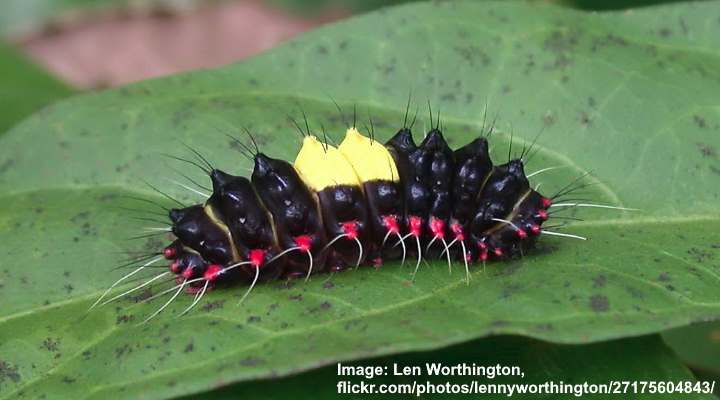
The Erasmia pulchella caterpillar has a shiny black body with yellow patch on the back, red dots on the sides and is covered with spikes
Erasmia Pulchella is a unique spiky black caterpillar native to southeast Asia. Unlike many other caterpillars, it has a more oval shape and is covered in black hairs, giving it a distinct appearance. What sets this caterpillar apart is the bright yellow patch on its middle back, along with red growths and white spikes along its sides. These features make it both striking and memorable.
Erasmia Pulchella typically feeds on Helicia shrubs and plants common in southeast Asia. While not venomous, this caterpillar has a defense mechanism against predators. When disturbed, it emits a foul-smelling substance from its tubercles, deterring potential threats.
When the Erasmia Pulchella undergoes pupation and emerges as a moth, it showcases a stunning range of colors, including black, bright white, deep red, and iridescent blue markings. The vibrancy of its wings can vary depending on environmental factors and climate.
- Adult Stage: Erasmia Pulchella matures into a beautiful, multi-colored moth with black, bright white, deep red, and iridescent blue markings. The coloration of the wings can vary depending on the moth’s environment and climate
- Host Plants: These spiky black caterpillars are known to feed on Helicia shrubs and plants commonly found in southeast Asia
- Habitat and Distribution: Erasmia Pulchella caterpillars are native to southeast Asia, where they thrive in various tropical habitats and regions.
- Stinging: Although Erasmia Pulchella is not a venomous caterpillar, it emits a noxious hydride compound from its tubercles when disturbed, serving as a natural defense mechanism against potential predators
Frequently Asked Questions about Black Caterpillars
Are black caterpillars types of worms?
Although some species of black caterpillars are called worms, there are not related. All caterpillars – black, green, striped, and furry – belong to the Insecta class. Worms are a type of invertebrate and are not classed as insects.
Are black caterpillars poisonous?
The majority of black caterpillars are not venomous and are harmless to humans. Some types of furry black caterpillars may have stinging barbs or spines that can cause skin irritations or dermatitis.
Only furry moth caterpillars may sting whereas butterfly caterpillars don’t sting.
Can furry black caterpillars predict winter?
Some people claim that the width of the brown band on the Wooly Bear caterpillar can predict the length of winter. However, this is not true and there is no evidence to back this claim.
Do caterpillars bite humans?
Although caterpillar can munch their way through a lot of leaves, their mouths are too small to bite humans.
Related articles:

